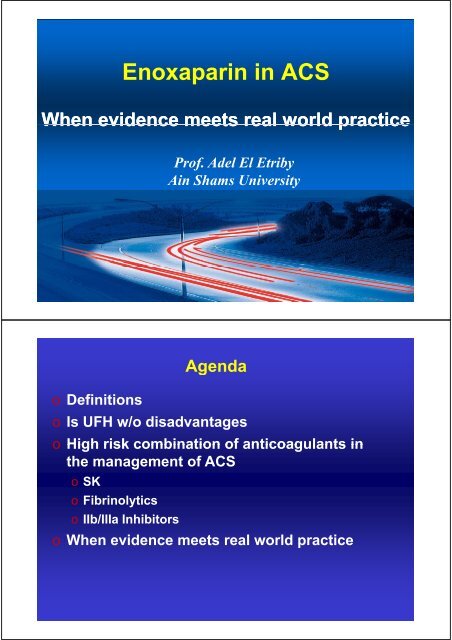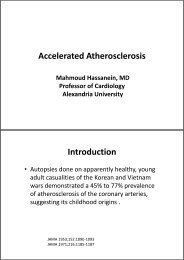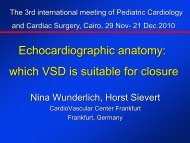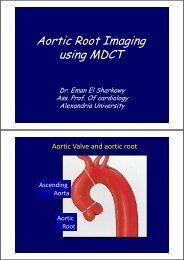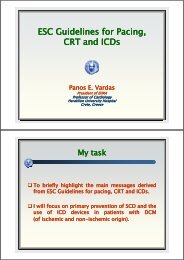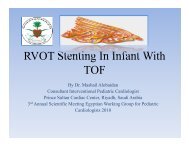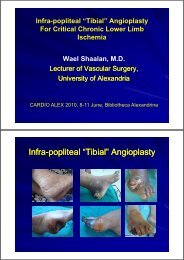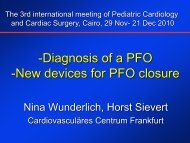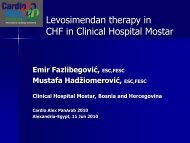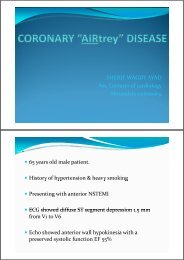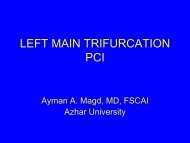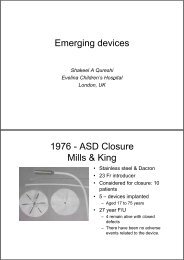Enoxaparin in ACS
Enoxaparin in ACS
Enoxaparin in ACS
Create successful ePaper yourself
Turn your PDF publications into a flip-book with our unique Google optimized e-Paper software.
<strong>Enoxapar<strong>in</strong></strong> <strong>in</strong> <strong>ACS</strong>When evidence meets real world practiceProf. Adel lElEt EtribyA<strong>in</strong> Shams Universityo Def<strong>in</strong>itionsAgendao Is UFH w/o disadvantageso High risk comb<strong>in</strong>ation of anticoagulants <strong>in</strong>the management of <strong>ACS</strong>o SKo Fibr<strong>in</strong>olyticso IIb/IIIa Inhibitorso When evidence meets real world practice
o Def<strong>in</strong>itionsAgendao Is UFH w/o disadvantageso High risk comb<strong>in</strong>ation of anticoagulants <strong>in</strong>the management of <strong>ACS</strong>o SKo Fibr<strong>in</strong>olyticso IIb/IIIa Inhibitorso When evidence meets real world practiceAcute Coronary Syndrome (<strong>ACS</strong>) Def<strong>in</strong>ed …ACUTE CORONARY SYNDROMENo ST ElevationST ElevationNSTEMIUnstable Ang<strong>in</strong>a NQMIQwMIMyocardial Infarction
o Def<strong>in</strong>itionsAgendao Is UFH w/o disadvantageso High risk comb<strong>in</strong>ation of anticoagulants <strong>in</strong>the management of <strong>ACS</strong>o SKo Fibr<strong>in</strong>olyticso IIb/IIIa Inhibitorso When evidence meets real world practiceIs UFH withoutdisadvantages?
Disadvantages of UFHo Unpredictable anticoagulant effect• Significant prote<strong>in</strong> b<strong>in</strong>d<strong>in</strong>g• Inactivation by platelet factor 4
Superiority of<strong>Enoxapar<strong>in</strong></strong> over UFHEvidence-basedo Def<strong>in</strong>itionsAgendao Is UFH w/o disadvantageso High risk comb<strong>in</strong>ation of anticoagulants <strong>in</strong>the management of <strong>ACS</strong>o SKo Fibr<strong>in</strong>olyticso IIb/IIIa Inhibitorso When evidence meets real world practice
Is UFH the choice when us<strong>in</strong>g SK?o SK + S.C. Hepar<strong>in</strong> didn’t improve outcomecompared with hepar<strong>in</strong>oGISSI- 2oISIS- 3o SK + I.V. Hepar<strong>in</strong> didn’t improve outcomeoGUSTO- 1o SK + I.V. Hepar<strong>in</strong> <strong>in</strong>crease the tendency formajor bleed<strong>in</strong>gAMI-SK Study designSTEMI(n=496)SK1.5 MU i.v.1 h+ aspir<strong>in</strong>(30 days)(n=491)<strong>Enoxapar<strong>in</strong></strong>30 mgbolus Angiography Follow-upi.v., thenday 8day 301 mg/kg s.c.q 12 h(3–8 days)(n=252)Placebo(3–8 days)(n=239)Angiographyday 8Follow-upday 30SK: Streptok<strong>in</strong>aseTreatment phaseFollow-up phase
Coronary patency (TIMI flow 2 or 3) at 8 dayssignificantly better with ClexanePa atients (% %)P
AMI-SK Conclusionso Clexane as adjunct to streptok<strong>in</strong>aseo facilitates early coronary reperfusiono reduces the risk of reocclusiono improved cl<strong>in</strong>ical outcome (death, MI, RA at 30days)o no significant <strong>in</strong>crease <strong>in</strong> major bleedso Def<strong>in</strong>itionsAgendao Is UFH w/o disadvantageso High risk comb<strong>in</strong>ation of anticoagulants <strong>in</strong>the management of <strong>ACS</strong>o SKo Fibr<strong>in</strong>olyticso IIb/IIIa Inhibitorso When evidence meets real world practice
<strong>Enoxapar<strong>in</strong></strong> versus UFH for STEMIOne Year Results fromExTRACT-TIMI 25E M. Antman, D. Morrow, C. McCabe, S. Murphy, H. White, K A A. Fox, and E.BraunwaldOn Behalf of the ExTRACT-TIMI 25 InvestigatorsProtocol DesignN = 20,506674 sites48 countriesSTEMI < 6 hLytic eligibleASALytic choice by MD(TNK, tPA, rPA, SK)Double-bl<strong>in</strong>d, bl<strong>in</strong>d, double-dummydummyENOX STRATEGY< 75 y: 30 mg IV bolusSC 1.0 mg / kg q 12 h (Hosp DC)≥ 75 y: No bolusSC 0.75mg / kg q 12 h (Hosp DC) )CrCl < 30: 1.0 mg / kg q 24 hUFH STRATEGY60 U / kg bolus (4000U)Inf 12 U/kg/h(1000/ U/h)Duration: at least 48 hCont’d at MD discretion1° Efficacy Endpo<strong>in</strong>t: Death or Nonfatal MI at 30 daysAdditional F/U at 6 mo and 1 yr
1ry Results at 30 DaysPrimary Endpo<strong>in</strong>t:Death or non-fatal re-MI by 30 daysMa<strong>in</strong> Secondary Endpo<strong>in</strong>t:Death, non-fatal re-MI, urgentrevascularization by 30 days%RR = 0.83p
No Increase <strong>in</strong> ICHents% Ev10UFHENOX86420ARD 0.7%RR 1.53ARD 0.4%RR 1.39ARD 0.1%RR 1.27P
Antithromb<strong>in</strong> therapy with a strategy of ENOXis superior to the standard strategy of UFH <strong>in</strong>STEMI patients undergo<strong>in</strong>g pharmacologicreperfusion across the spectrum of lytics used<strong>in</strong> ExTRACT-TIMI 25
New Data from ExTRACT-TIMI 251YEAR FOLLOW UPESC 2007To determ<strong>in</strong>e if the benefits of theENOX strategy over the UFHstrategy were susta<strong>in</strong>ed through 1 yr.Methods• Telephone Tl follow-up fll at 6 and 12 monthsDeath from any causeRecurrent MIStroke→ 1yrfollow-up available on 99% of ITT cohort• CRF documentationSame endpo<strong>in</strong>t pages as ma<strong>in</strong> trial Investigator-reported• Statistical Analysis:Intention-to-treat, treat, Log Rank
Primary End Po<strong>in</strong>t (ITT)Death/MI at 1 Year18 UFH17.0%Po<strong>in</strong>t (%%)Primaary End1614121012.0%9.9%8 RR0.836 (0.77to 0.90)P
Net Cl<strong>in</strong>ical BenefitDeath/MI/Disabl<strong>in</strong>g Stroke at 1 yrEnd Poo<strong>in</strong>t (%)181614 12.3%1210 10.1%8 RR0.826 (0.76to 0.89)4 P
Elements of 1ry Endpo<strong>in</strong>t at 1 Year%)Po<strong>in</strong>t (%End P12108642All Cause MortalityUFH 10.6%ENOX 10.5%HR0.98(0.90to 1.0707)P=0.776Non-fatal MIUFH6.8%5.7%5 ENOX43 HR0.822(0.73to 0.9292)1P=0.0006000600 50 100 150 200 250 300 350Days00 50 100 150 200 250 300 350DaysSummary-11. The benefits of the ENOX strategytover the UFH strategy <strong>in</strong> reduc<strong>in</strong>gDeath/MI was susta<strong>in</strong>ed at 1 yr2. The 1 yr benefit of the ENOXstrategy is driven by the earlyreduction <strong>in</strong> reMI
Summary-23. Net cl<strong>in</strong>ical benefit significantlyfavors the ENOX strategy both at 30days and 1 yr.Cl<strong>in</strong>ical Implications for Managementof fSTEMIThe ENOX strategy to support fibr<strong>in</strong>olysisis preferable to that of UFH:Early superiority <strong>in</strong> reduc<strong>in</strong>g death/MIDurable treatment benefit
o Def<strong>in</strong>itionsAgendao Is UFH w/o disadvantageso High risk comb<strong>in</strong>ation of anticoagulants <strong>in</strong>the management of <strong>ACS</strong>o SKo Fibr<strong>in</strong>olyticso IIb/IIIa Inhibitorso When evidence meets real world practice<strong>Enoxapar<strong>in</strong></strong> <strong>in</strong>comb<strong>in</strong>ation withGPIIb/IIIa <strong>in</strong>hibitors
<strong>Enoxapar<strong>in</strong></strong> and GP IIb/IIIa <strong>in</strong>hibitors <strong>in</strong>UA/NSTEMI‣ ACUTE II: second Antithrombotic Comb<strong>in</strong>ation Us<strong>in</strong>gTirofiban and <strong>Enoxapar<strong>in</strong></strong>Cohen M et al. Am Heart J 2002‣ INTERACT: Integril<strong>in</strong> and <strong>Enoxapar<strong>in</strong></strong>RandomizedAssessment of Acute Coronary Syndromes TreatmentGoodman S et al. Circulation 2003‣ SYNERGY: SuperiorYield of the New strategy of <strong>Enoxapar<strong>in</strong></strong>,Revascularization & GlYcoprote<strong>in</strong> IIb/IIIa InhibitorsACUTE II: TIMI Bleed<strong>in</strong>g EventsTirofiban + UFH (n=210)Tirofiban + enoxapar<strong>in</strong> (n=315)TIMI-major0.31.0P=NSTIMI-m<strong>in</strong>or2.54.3P=NSTIMI-“lossno site”3.54.8P=NS0 1 2 3 4 5Patients (%)
%1098765432104.8%INTERACT(Aspir<strong>in</strong> + Integril<strong>in</strong>)UH<strong>Enoxapar<strong>in</strong></strong>P = 0.03031.8%MB 96 hrs25.4%P = 0.030314.3%Death/MI 30dNICE - 3NationalInvestigatorsCollaborat<strong>in</strong>g on <strong>Enoxapar<strong>in</strong></strong>
NICE -3Objectiveso To assess the safety yp profile (primarily withrespect to bleed<strong>in</strong>g) of enoxapar<strong>in</strong> and a IIb/IIIaantagonist (abciximab, eptifibatide or tirofiban) <strong>in</strong>patients with <strong>ACS</strong>o To assess the feasibility and safety of br<strong>in</strong>g<strong>in</strong>gpatients t forward to the catheterization t ti laboratoryon comb<strong>in</strong>ation therapy (without the use of UFhepar<strong>in</strong>)NICE -3Protocol661 patients enrolledAll treated t with<strong>Enoxapar<strong>in</strong></strong>46 cl<strong>in</strong>ical sites <strong>in</strong>US / CanadaStudy Initiatedt January 2000[<strong>Enoxapar<strong>in</strong></strong>alone](n=45)Tirofiban(n=217)Eptifibatide(n=252)All IIb/IIIa patients(n=616)Abciximab(n=147)Enrollment CompletedMay 2000In-hospital, 14-day, and 30-day follow-upData availableAugust 2000
NICE - 3151214Major Bleed<strong>in</strong>g910Non-CABG Major Bleed<strong>in</strong>g10.6630EPICNICE-3 4.5%4.13.8CAPTURENICE-3 1.9%21.51.1 0.85.3 5.12.41.4? ?EPILOG EPISTENT RESTORE PRISM+ IMPACT II PURSUIT3NICE -3Conclusionso Comb<strong>in</strong>ation of enoxapar<strong>in</strong> plus GPIIb/IIIaantagonists does NOT result <strong>in</strong> major non-CABGbleed<strong>in</strong>g.o Patients on comb<strong>in</strong>ation therapy may safelyundergo PCI.o <strong>Enoxapar<strong>in</strong></strong> could be prescribed follow<strong>in</strong>gthrombolytics (tenecteplase, SK) without<strong>in</strong>crease risk of ICH.
o Def<strong>in</strong>itionsAgendao Is UFH w/o disadvantageso High risk comb<strong>in</strong>ation of anticoagulants <strong>in</strong>the management of <strong>ACS</strong>o SKo Fibr<strong>in</strong>olyticso IIb/IIIa Inhibitorso When evidence meets real world practiceReasons for Quitt<strong>in</strong>g UFH <strong>in</strong> PCI1.Anticoagulation with UFH is unpredictable–In STEEPLE, only 20% of patients were <strong>in</strong> the“official” target range2.Frequent medical errors with UFH• LaPo<strong>in</strong>te NM, Jollis JG. Arch InternMed. 2003;163:1461-1466.1461 14663.Clexane is safer, more effective & easier to3.Clexane is safer, more effective & easier touse
Task Force Recommendations6 Rx studies(enoxapar<strong>in</strong>)<strong>ACS</strong>1 mg/kg SC BID 11 Rx studies(enoxapar<strong>in</strong>)PCIno add. LMWH Elective PCI 1° PCICATH LAB with<strong>in</strong> 8 hours 0.5 mg/kg IV 0.5 mg/kg IV?5 non-Rx studies(enoxapar<strong>in</strong>)Def<strong>in</strong>itive Evaluation of <strong>Enoxapar<strong>in</strong></strong> AcrossCAD/<strong>ACS</strong> Spectrum > 50,000 patientsUA/NSTEMIMeta-analysisN=21,946patientsSTEMIMetaanalysisN>27,000patientstElective PCIMeta-analysisN>7,000patientsReduction <strong>in</strong> death/re-MI10% 22%Reduction <strong>in</strong> major bleed<strong>in</strong>g43%Murphy SA, et al. Eur Heart J. 2007; Epub ahead of pr<strong>in</strong>tDuma<strong>in</strong>e R, et al. Arch Int Med (<strong>in</strong> press)
Clexane <strong>in</strong> <strong>ACS</strong> – My Approach<strong>ACS</strong>Conservative StrategyInvasive StrategySTEMI NSTEMI • Prolonged procedure• Post CABG• No ACT availableNo Cathlab Glycoprote<strong>in</strong>• On Clexane <strong>in</strong> CCUWith<strong>in</strong> 3 hoursIIb/IIIaSK + fullFull lldoseClexane IVdose Clexane Clexane0.5 mg/kgConclusionsWhen mak<strong>in</strong>g a a decision for propermanagement of patients with <strong>ACS</strong> weshould comb<strong>in</strong>e EBM with common sense.When us<strong>in</strong>g both,Clexane seems to be the bestchoice
Thank You..SummaryoComb<strong>in</strong><strong>in</strong>g Clexane with SK or thrombolytics providesbetter ST resolution & reperfusion as well as cl<strong>in</strong>icalevents suggest<strong>in</strong>g less re-occlusion.o Comb<strong>in</strong><strong>in</strong>g Clexane with GPIIb/IIIa receptor antagonistsdid not <strong>in</strong>crease major – non CABG bleed<strong>in</strong>g.o Patients on comb<strong>in</strong>ation therapy (Clexane + GPIIb/IIIa RA)may safely undergo PCI.o Clexane could be prescribed follow<strong>in</strong>g thrombolytics(tenecteplase, SK) without <strong>in</strong>crease risk of ICH.
Egyptian Guidel<strong>in</strong>es for themanagement of <strong>ACS</strong>Low Molecular Weight Hepar<strong>in</strong>:<strong>Enoxapar<strong>in</strong></strong> was the only LMWH which showed benefit over UFH onhard end-po<strong>in</strong>tsof death, MI or need for urgent revascularizationi(ESSENCE trial).-Dose: 1 mg/kg/12hours subcutaneously.-Duration: from 2-8days.Both Nd Nadropar<strong>in</strong>e and Dlt Daltepar<strong>in</strong> did not show any advantage overUFH on hard end po<strong>in</strong>ts (FRIC &FRAXIStrials).Most studies showed no benefit of long term treatment by LMWH’sexcept <strong>in</strong> patients with elevated Tropon<strong>in</strong> (30days).


